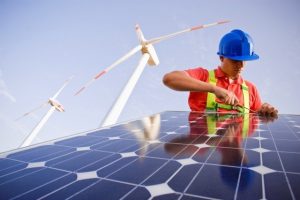 California experienced one of the worst wildfire seasons in its history last year. In response to widespread devastation, the state’s legislature introduced a bill last week, SB 1088, requiring regulators to establish fire risk reduction and mitigation standards for utilities. Environmental Defense Fund (EDF) strongly supports compensating Californians harmed by the fires and taking steps to prevent future fires. However, as currently written, the bill includes unnecessary provisions that would severely limit Californians’ access to distributed energy resources. Ironically, these are the tools that can help the state more quickly and cheaply fight climate change – a large contributor to its fire risk.
California experienced one of the worst wildfire seasons in its history last year. In response to widespread devastation, the state’s legislature introduced a bill last week, SB 1088, requiring regulators to establish fire risk reduction and mitigation standards for utilities. Environmental Defense Fund (EDF) strongly supports compensating Californians harmed by the fires and taking steps to prevent future fires. However, as currently written, the bill includes unnecessary provisions that would severely limit Californians’ access to distributed energy resources. Ironically, these are the tools that can help the state more quickly and cheaply fight climate change – a large contributor to its fire risk.
The bill’s prohibition of customer and third party-owned distributed resources is broad enough to threaten a wide variety of clean energy resources, without giving them a chance to grow. Distributed resources include battery storage, including electric vehicles, which will allow Californians to capture the power of the sun during the day and use it in the evening. Energy efficiency and demand response are distributed resources that help reduce the state’s reliance on transmission lines and fossil fuel power plants, while keeping people’s bills low. Distributed solar plays a vital role in the state’s electric grid and is helping to improve local air quality and cut global warming pollution.
Distributed resources are innovative technologies that California needs in order to keep nurturing local economies in a way that preserves community authority and control. At the same time, distributed resources can help us avoid the most devastating effects of climate change. This is why EDF, along with Environment California and California League of Conservation Voters, sent a letter of opposition to the bill’s author expressing our concerns.
[Tweet “California bill aimed at wildfires effectively bans clean energy that may help prevent them”]
How does the bill restrict clean, distributed energy?
Specific sections currently included in the bill would cripple the distributed energy resources industry’s ability to provide services and the state’s ability to meet its climate change objectives while providing electricity in safe, low-cost ways. California lawmakers should change the following sections of the bill to ensure clean energy solutions continue to thrive:
- Language prohibiting electrical corporations from contracting out “distribution safety or reliability performance obligations.” This includes, “owning, controlling, operating, managing, maintaining, planning, engineering, designing, investing in, and constructing the distribution system.” (Section 2899.3(a)(b)&(c))
- A finding that the California Public Utilities Commission should not “rely” on unregulated entities in lieu of public utilities to provide electric safety and reliability. (Section 1, Finding (f))
Distributed resources connect to the electric grid at dispersed locations throughout our communities, owned and managed by a variety of entities, like individuals, businesses, and local governments. Because of their diverse ownership and operation, they are the practical solutions critical to California’s economic and clean energy growth. They also act quickly to help prevent climate change and reduce pollution. The bill’s current language would effectively prohibit this type of clean energy resource by preventing customer and third-party ownership, maintaining business as usual.
What’s next?
In order for California to avoid the devastating impacts of climate change, including wildfires, we need to continue to rely more on clean energy resources and less on fossil fuels.
In order for California to avoid the devastating impacts of climate change, including wildfires, we need to continue to rely more on clean energy resources and less on fossil fuels to power the state’s homes and businesses, and we need to use every tool available. We recommend lawmakers look for solutions that bring together the distributed energy resource industry and the labor industry, creating a truly clean economy with a prosperous workforce. There is an opportunity for everyone to gain and for California to thrive in an increasingly distributed world.
EDF encourages utilities take steps to prevent their systems from causing fires, especially when every year is hotter than the last. However, it does not make sense to strip distributed electricity providers of their ability to offer services that can help meet California’s needs in a safe, flexible, and potentially less expensive way. We will need both large and small clean energy solutions as a part of California’s future.
California is a world leader when it comes to clean energy technologies, and the state’s optimism, vision, and industry leadership can help reduce the severe impacts of changing climate, including wildfires. We need to maintain the ability to innovate and succeed in ways that are safe, clean, and reliable in the fight against climate change and in the pursuit of a clean energy economy.










One Comment
This whole article is misleading. The bill is not saying that others cannot help make the system safer.
And more distributed energy in the form of renewables will actually cause MORE potential for future fires. Intermittent resources require more transmission and more distribution in order to “even out” the intermittency over larger distances. Billions of dollars of grid expansions are being planned in California to accommodate more renewables.
Someone has to own the grid – California cannot put responsibility for a large integrated system onto a bunch of small, possibly resource-challenged distributed energy providers. This is why rules governing CCAs need to change. EDF should be looking at how to ensure that all electric customers pay their fair share in managing the grid because it’s complicated and, as there are more severe weather events, the challenges will grow.